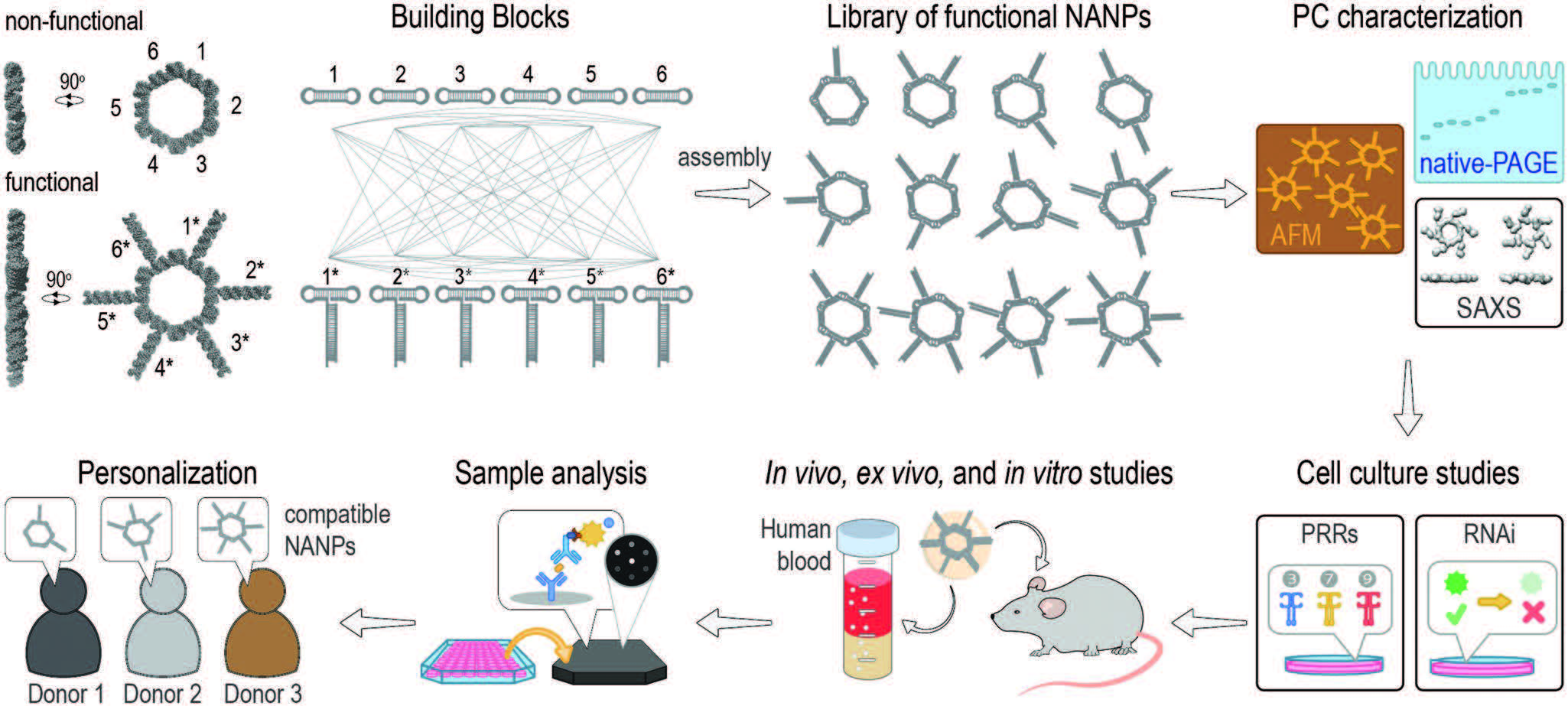| Aug 15, 2022 | |
Identifying favorable immunological profiles suitable for personalized treatments with RNA nanoparticles |
|
| (Nanowerk Spotlight) Therapeutic nucleic acids (TNAs) and nucleic acid nanoparticles (NANPs) are designed to enact specific intracellular responses beneficial for various biomedical applications. TNAs become especially attractive to researchers and clinicians since their functional versatility, programmability and modularity show great promise for treating disorders such as viral infections, cancers, and genetic disorders. | |
| However, unfavorable stimulation of the innate immune system by TNAs has proven to be a major hurdle for the accelerated transition and broader applications of TNAs in clinical settings. The ability to define the way TNAs interact with the immune system is highly desirable and becomes possible through the incorporation of TNAs onto specifically structured NANPs that can also promote the synchronized delivery of therapeutic cocktails composed of different TNAs. | |
| The use of NANPs as scaffolds allows for the TNAs to be presented in an ordered fashion, which in turn provides flexibility in delivering TNAs selected for personalized treatments. | |
| Previous works showed that the immune responses to NANPs change with various factors such as dimensionality (3D vs. 2D), composition (DNA vs. RNA), and functionalization with TNAs. | |
| A current work published in Advanced Functional Materials ("Expanding Structural Space for Immunomodulatory Nucleic Acid Nanoparticles (Nanps) via Spatial Arrangement of Their Therapeutic Moieties") by a team of scientists from the University of North Carolina at Charlotte, Nanotechnology Characterization Lab, and Clemson University, further investigated the effect of functionalization on immunorecognition of NANPs. | |
| For that, a panel of NANPs composed entirely of RNA functionalized with Dicer Substrate (DS) RNAs positioned in all possible orientations was extensively characterized in various reporter cell lines and animal models. Functional DS RNAs are TNAs designed for intracellular dicing that releases siRNAs able to silence the production of specific target genes. The representative NANPs in the panel were chosen to be programmable hexagonal rings composed of six monomers able to carry up to six TNAs reliably placed in any position. | |
 |
|
| Schematic representation of experimental flow reported in this work. The library of functional NANPs with different numbers and orientations of Dicer Substrate (DS) RNAs was engineered and extensively characterized and tested in vitro, in vivo, and in human peripheral blood mononuclear cells (PBMCs) to determine NANPs immunostimulatory properties. (Reprinted with permission by Wiley-VCH Verlag) (click on image to enlarge) | |
| The team of researchers used various methods to investigate the panel's structural parameters and intracellular activity, including uptake into various mammalian cells, assessing their gene silencing efficacy, and immune stimulation of reporter cell lines, all of which were followed by the investigation of immunostimulation in animal models. Finally, the trends across the panel were further investigated using peripheral blood mononuclear cells (PBMCs) from human donors to assess person-to-person variability and the suitability of this approach for personalized medicine. | |
| Utilizing immune reporter assays, the team examined the activation of various pathways (e.g., IRF and NF-kB) to investigate which cytokines are being produced in response to each NANP treatment. These assays showed significant immunostimulation in response to all the NANPs carrying DS RNAs. However, the non-functionalized rings did not lead to detectable stimulation. | |
| Interestingly, the activation of retinoic acid inducible gene-I (RIG-I), one of the key cytosolic immune receptors for the detection of foreign RNA, was shown to be dependent on the arrangement of DS RNAs around the NANP, with the higher number of DS RNAs hindering the response from RIG-I when compared to those with spacing between TNAs. | |
| The in vivo cytokine analysis results further confirmed that the TNA orientation does play a role in immune activation. Another exciting takeaway from these experiments was that there was some cytokine production in the brain, indicating that the NANPs could potentially be delivered through the blood-brain barrier using poly(lactide-co-glycolide)-graft-polyethyleneimine as a carrier. This indicates that the delivery of therapeutic NANPs to the central nervous system may be an achievable goal in the near future. | |
| Overall, the extent of functionalization of NANPs with TNAs and their relative orientations showed a distinct trend in immunostimulation both in human PBMCs and in animal models. Rings that were functionalized with the most spaced out TNAs led to the higher levels of immune response in both reporter cell lines and PBMC cultures. | |
| This finding indicates that the extra space may allow for more efficient receptor binding, which in turn leads to the observed differences in immunostimulation. This differential response shows that the tertiary structure of NANPs may influence their delivery and interactions with cognate PRRs thus, resulting in various levels of immune stimulation. | |
| By understanding the immunorecognition of NANPs and tailoring NANPs design and functionalization based on the desired level of immune response, the scaffold itself can be tuned from an immunoquiescent to an immunostimulatory platform by incorporating TNAs in specific positions. | |
| The advancement of the current TNA approach towards personalized medicine offers new strategies to address relevant public health challenges while also providing a biodegradable, functional platform with tunable immune responses. The modularity of this platform allows it to function as a personalized drug delivery platform, and treatment options can be customized depending on the desired applications for the optimal drug design. | |
| Source: Provided by Afonin Lab, Department of Chemistry, The University of North Carolina at Charlotte | |
|
Become a Spotlight guest author! Join our large and growing group of guest contributors. Have you just published a scientific paper or have other exciting developments to share with the nanotechnology community? Here is how to publish on nanowerk.com. |
|
